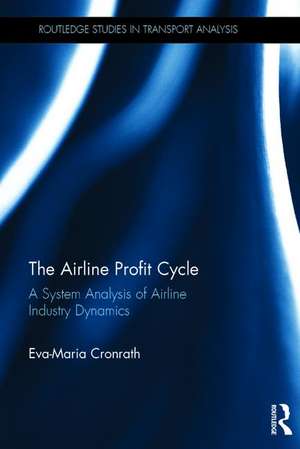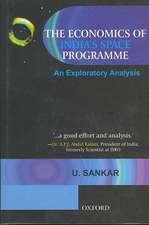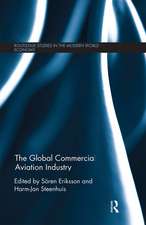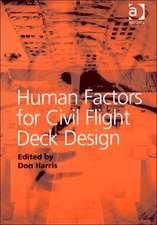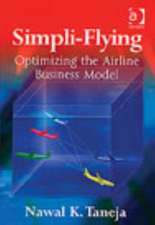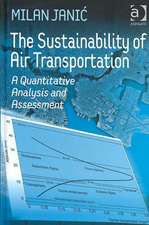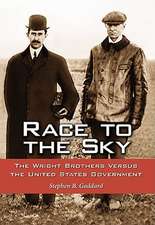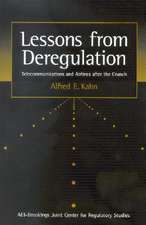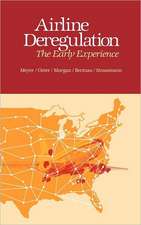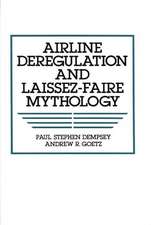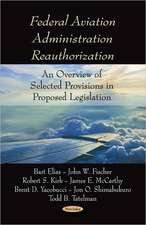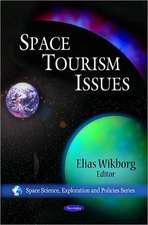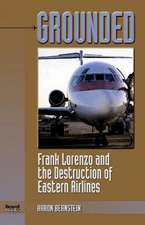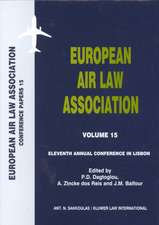The Airline Profit Cycle: A System Analysis of Airline Industry Dynamics: Routledge Studies in Transport Analysis
Autor Eva-Maria Cronrathen Limba Engleză Hardback – 30 iun 2017
This is the first in-depth examination of the airline profit cycle. The airline industry is modelled as a complex dynamic system, which is used for quantitative simulations of ‘what if’ scenarios. These experiments reveal that the general economic environment, such as GDP or fuel price developments, influence the airline industry’s profitability pattern as well as certain regulations or aircraft manufactures’ policies. Yet despite all circumstances, simulations show that airlines’ own management decisions are sufficient to generate higher and more stable profits in the industry.
This book is useful for aviation industry decision makers, investors, policy makers, and researchers because it explains why the airline industry earns or loses money. This knowledge will advance forecasting and market intelligence. Furthermore, the book offers practitioners different suggestions to sustainably improve the airline industry’s profitability. The book is also recommended as a case study for system analysis as well as industry cyclicality at graduate or postgraduate level for courses such as engineering, economics, or management.
| Toate formatele și edițiile | Preț | Express |
|---|---|---|
| Paperback (1) | 390.63 lei 6-8 săpt. | |
| Taylor & Francis – 14 aug 2020 | 390.63 lei 6-8 săpt. | |
| Hardback (1) | 851.40 lei 6-8 săpt. | |
| Taylor & Francis – 30 iun 2017 | 851.40 lei 6-8 săpt. |
Din seria Routledge Studies in Transport Analysis
-
 Preț: 326.49 lei
Preț: 326.49 lei -
 Preț: 309.99 lei
Preț: 309.99 lei -
 Preț: 290.57 lei
Preț: 290.57 lei - 16%
 Preț: 260.13 lei
Preț: 260.13 lei - 17%
 Preț: 259.98 lei
Preț: 259.98 lei -
 Preț: 422.00 lei
Preț: 422.00 lei - 17%
 Preț: 259.98 lei
Preț: 259.98 lei -
 Preț: 425.86 lei
Preț: 425.86 lei - 17%
 Preț: 258.59 lei
Preț: 258.59 lei -
 Preț: 390.63 lei
Preț: 390.63 lei -
 Preț: 389.66 lei
Preț: 389.66 lei -
 Preț: 389.66 lei
Preț: 389.66 lei -
 Preț: 389.66 lei
Preț: 389.66 lei - 17%
 Preț: 259.98 lei
Preț: 259.98 lei - 16%
 Preț: 248.41 lei
Preț: 248.41 lei -
 Preț: 382.32 lei
Preț: 382.32 lei -
 Preț: 387.16 lei
Preț: 387.16 lei - 18%
 Preț: 1013.39 lei
Preț: 1013.39 lei - 18%
 Preț: 1008.17 lei
Preț: 1008.17 lei - 9%
 Preț: 1004.93 lei
Preț: 1004.93 lei - 9%
 Preț: 936.45 lei
Preț: 936.45 lei
Preț: 851.40 lei
Preț vechi: 1142.61 lei
-25% Nou
162.93€ • 169.07$ • 136.18£
Carte tipărită la comandă
Livrare economică 15-29 martie
Specificații
ISBN-10: 113873196X
Pagini: 342
Ilustrații: 362
Dimensiuni: 156 x 234 x 26 mm
Greutate: 0.66 kg
Ediția:1
Editura: Taylor & Francis
Colecția Routledge
Seria Routledge Studies in Transport Analysis
Locul publicării:Oxford, United Kingdom
Public țintă
Postgraduate and UndergraduateCuprins
List of Figures
List of Tables
Foreword by Peter-M. Milling
Foreword by R. John Hansman
Preface
1. The airline profit cycle as a persistent phenomenon
1.1. The development of airline traffic and cyclic financial results
1.2. Consequences of the airline profit cycle
1.3. Research objective and approach
2. Potential causes of the airline profit cycle
2.1. Literature review on business cycle drivers
2.2. Systems literature on cyclical dynamics
2.3. Existing airline profit cycle research
2.4. Industry practitioners’ views on airline profit cyclicality
2.5. Categorisation of airline profit cycle drivers
3. System Dynamics model of airline industry profit development
3.1. Need for a System Dynamics analysis
3.2. Outline of the airline profit cycle model
3.3. Decision design and mechanisms in the model
3.4. Validation of model structure
3.5. Calibration of the model for the U.S. airline industry
3.6. Confidence in the model’s behaviour and results
4. Examination of airline profitability dynamics in model experiments
4.1. Identification of cycle origin area
4.2. Approach to scenario analysis and sensitivity assessment
4.3. Influence of general economic factors on airline profits
4.4. Impact of airline industry environment on airlines’ financial performance
4.5. Airlines’ behaviour as driver of cyclicality
4.6. Main causes and dynamics constituting the airline profit cycle
5. Conclusions for the airline industry
6. References
7. Appendix
7.1. Appendix A: Cost classification
7.2. Appendix B: Background information ATA Cost Index
7.3. Appendix C: Airline profit cycle model data and equations
Index
Descriere
The air transport industry has high economic impact; it supports more than 60 million jobs worldwide. Since the early years of commercial air travel, passenger numbers have grown tremendously. However, for decades airlines' financial results have been swinging between profits and losses.
The airline industry's aggregate net average profit between 1970 and 2010 was close to zero, which implies bankruptcies and layoffs in downturns. The profit cycle's amplitude has been rising over time, which means that problems have become increasingly severe and also shows that the industry may not have learned from the past. More stable financial results could not only facilitate airline management decisions and improve investors' confidence but also preserve employment.
This book offers a thorough understanding of the airline profit cycle's causes and drivers, and it presents measures to achieve a higher and more stable profitability level. This is the first in-depth examination of the airline profit cycle. The airline industry is modelled as a complex dynamic system, which is used for quantitative simulations of `what if' scenarios.
These experiments reveal that the general economic environment, such as GDP or fuel price developments, influence the airline industry's profitability pattern as well as certain regulations or aircraft manufactures' policies. Yet despite all circumstances, simulations show that airlines' own management decisions are sufficient to generate higher and more stable profits in the industry. This book is useful for aviation industry decision makers, investors, policy makers, and researchers because it explains why the airline industry earns or loses money.
This knowledge will advance forecasting and market intelligence. Furthermore, the book offers practitioners different suggestions to sustainably improve the airline industry's profitability. The book is also recommended as a case study for system analysis as well as industry cyclicality at graduate or postgraduate level for courses such as engineering, economics, or management.
